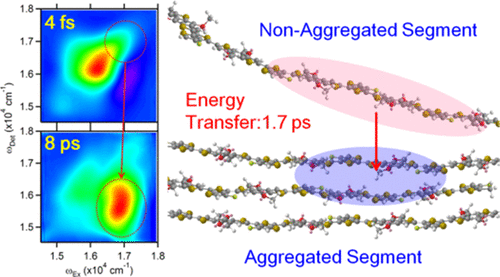当前位置:
X-MOL 学术
›
Macromolecules
›
论文详情
Our official English website, www.x-mol.net, welcomes your
feedback! (Note: you will need to create a separate account there.)
Excitation Energy Transfer Dynamics in a Low-Band-Gap Copolymer: Two-Dimensional Electronic Spectroscopy of PTB7 in Solution
Macromolecules ( IF 5.1 ) Pub Date : 2020-11-11 , DOI: 10.1021/acs.macromol.0c01118 Takumi Nakamura 1
Macromolecules ( IF 5.1 ) Pub Date : 2020-11-11 , DOI: 10.1021/acs.macromol.0c01118 Takumi Nakamura 1
Affiliation

|
A series of donor–acceptor (D–A)-linked copolymers has been used extensively in organic photovoltaics. Poly({4,8-bis[(2-ethylhexyl)oxy]benzo[1,2-b:4,5-b′]dithiophene-2,6-diyl}3-fluoro-2-[(2-ethylhexyl)carbonyl]thieno[3,4-b]thiophenediyl) (PTB7) is a member of benzodithiophene-thieno[3,4-b]thiophene-linked copolymers, and its D–A-linked structure leads to strong aggregation among polymer strands in films and solution phases. In particular, PTB7 in a dilute solution consists of nonaggregated and aggregated (self-aggregated) segments in an isolated chain. Aggregated and nonaggregated structures impact significantly the steady-state fluorescence spectrum. The fluorescence band of nonaggregated segments overlaps largely with the lowest absorption band of aggregated segments. This spectral property is expected to affect primary excitation energy transfer (EET) and relaxation dynamics following photoexcitation. The present study reports that primary EET and relaxation processes in PTB7 in toluene are examined with two-dimensional electronic spectroscopy (2DES). The time evolution of spectral signatures in the 2DES is well examined with four kinetic exponents, i.e., 32 fs, 97 fs, 310 fs, and 1.7 ps. The relaxation processes differ in aggregated and nonaggregated segments. In aggregated segments, excitation is localized in 32 fs and then the excitation energy transfer to lower-energy sites in aggregated segments in 310 fs. In nonaggregated segments, the 32 fs excitation localization involves changes of the exciton sizes into approximately two repeating units. After excitation localization, pseudo-charge-transfer (PCT) and charge-separated (CS) states are formed in nonaggregated segments with a time constant of 97 fs. Additionally, the formation of the PCT and CS states competes with relaxation processes to lower exciton states in the manifold. Notably, the time evolution of 2DES reveals that the EET occurs from a nonaggregated segment to an aggregated segment in 1.7 ps. The 1.7 ps EET may originate from the large spectral overlap between the fluorescence and absorption bands; i.e., the density of states (DOS) of donors matches energetically to the DOS of acceptors.
中文翻译:

低能隙共聚物中的激发能传递动力学:溶液中PTB7的二维电子光谱
一系列供体-受体(DA)连接的共聚物已广泛用于有机光伏中。聚({4,8-双[(2-乙基己基)氧基]苯并[1,2- b:4,5 - b ']二噻吩-2,6-二基} 3-氟-2-[(2-乙基己基)羰基]噻吩并[3,4- b ]噻吩二基)(PTB7)是苯并二噻吩-噻吩并[3,4- b]噻吩连接的共聚物及其D–A连接的结构导致薄膜和溶液相中聚合物链之间的强聚集。特别是,稀溶液中的PTB7由孤立链中的非聚集和聚集(自聚集)链段组成。聚集和非聚集结构会显着影响稳态荧光光谱。非聚集片段的荧光带与聚集片段的最低吸收带在很大程度上重叠。预期该光谱特性会影响光激发后的一次激发能转移(EET)和弛豫动力学。本研究报告说,采用二维电子光谱法(2DES)检查了甲苯中PTB7中的主要EET和弛豫过程。2DES中频谱特征的时间演变通过四个动力学指数(即32 fs,97 fs,310 fs和1.7 ps)得到了很好的检验。松弛过程在聚合段和非聚合段中有所不同。在聚集段中,激发位于32 fs内,然后激发能量在310 fs内转移到聚集段中的低能位。在非聚集段中,32 fs激发定位涉及将激子大小改变为大约两个重复单元。在激发定位之后,伪电荷转移(PCT)和电荷分离(CS)状态在非聚集段中以97 fs的时间常数形成。另外,PCT和CS状态的形成与弛豫过程竞争,以降低歧管中的激子状态。值得注意的是 2DES的时间演变表明,EET在1.7 ps的时间内从非聚集段变为聚集段。1.7 ps EET可能源自荧光带和吸收带之间的大光谱重叠;也就是说,供体的状态密度(DOS)与接受体的DOS能量匹配。
更新日期:2020-11-25
中文翻译:

低能隙共聚物中的激发能传递动力学:溶液中PTB7的二维电子光谱
一系列供体-受体(DA)连接的共聚物已广泛用于有机光伏中。聚({4,8-双[(2-乙基己基)氧基]苯并[1,2- b:4,5 - b ']二噻吩-2,6-二基} 3-氟-2-[(2-乙基己基)羰基]噻吩并[3,4- b ]噻吩二基)(PTB7)是苯并二噻吩-噻吩并[3,4- b]噻吩连接的共聚物及其D–A连接的结构导致薄膜和溶液相中聚合物链之间的强聚集。特别是,稀溶液中的PTB7由孤立链中的非聚集和聚集(自聚集)链段组成。聚集和非聚集结构会显着影响稳态荧光光谱。非聚集片段的荧光带与聚集片段的最低吸收带在很大程度上重叠。预期该光谱特性会影响光激发后的一次激发能转移(EET)和弛豫动力学。本研究报告说,采用二维电子光谱法(2DES)检查了甲苯中PTB7中的主要EET和弛豫过程。2DES中频谱特征的时间演变通过四个动力学指数(即32 fs,97 fs,310 fs和1.7 ps)得到了很好的检验。松弛过程在聚合段和非聚合段中有所不同。在聚集段中,激发位于32 fs内,然后激发能量在310 fs内转移到聚集段中的低能位。在非聚集段中,32 fs激发定位涉及将激子大小改变为大约两个重复单元。在激发定位之后,伪电荷转移(PCT)和电荷分离(CS)状态在非聚集段中以97 fs的时间常数形成。另外,PCT和CS状态的形成与弛豫过程竞争,以降低歧管中的激子状态。值得注意的是 2DES的时间演变表明,EET在1.7 ps的时间内从非聚集段变为聚集段。1.7 ps EET可能源自荧光带和吸收带之间的大光谱重叠;也就是说,供体的状态密度(DOS)与接受体的DOS能量匹配。











































 京公网安备 11010802027423号
京公网安备 11010802027423号